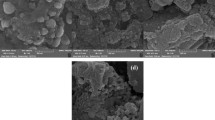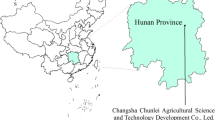Abstract
In this study, the microwave digestion method was used to determine total cadmium (Cd) and lead (Pb) concentrations, the BCR method was used to determine different states of Cd and Pb, and atomic absorption spectroscopy (AAS) and inductively coupled plasma optical emission spectrometry (ICP-OES) were used to determine Cd and Pb concentrations in simulated soil and barnyard grass before and after planting barnyard grass to provide a theoretical basis for the remediation of Cd- and Pb-contaminated soil. The results showed that the bioconcentration factor changes with different Cd concentrations are relatively complex and that the removal rate increases regularly. The 100 mg kg−1 Cd treatment had the highest removal rate, which reached 36.66%. For Pb, the bioconcentration factor decreased and tended to reach equilibrium as the Pb concentration increased. The highest removal rate was 41.72% and occurred in the 500 mg kg−1 Pb treatment; however, this removal rate was generally lower than that of Cd. In addition, the reduction state had the highest change rate, followed by the residual, acid soluble and oxidation states. For Pb, the residual state has the highest change rate, followed by the acid soluble state, reduction state and oxidation state. In addition, a significant correlation was observed between the soil Pb and Cd concentrations and the concentrations of Pb and Cd that accumulated in the belowground biomass of the barnyard grass, but no significant correlation was observed between the soil Pb and Cd concentrations and the amounts of Pb and Cd that accumulated in the aboveground biomass of the barnyard grass. The highest transfer factor of Cd was 0.49, which occurred in the 5 mg kg−1 Cd treatment. The higher transfer factor of Pb was 0.48 in the 100 mg kg−1 Pb treatment. All of these factors indicate that the belowground biomass of barnyard grass plays a more important role in the remediation of Cd- and Pb-contaminated soils than the aboveground biomass of barnyard grass. Remediation should occur through phytostabilization. Thus, with its strong adaptability and lush growth, barnyard grass can be applied as a pioneer species for the phytoremediation of Cd- and Pb-contaminated soils.








Similar content being viewed by others
References
Cao, H. C., Luan, Z. Q., Wang, J. D, & Zhang, X. L. (2008). Chemical speciation of CD and Pb in black soil and its effect on plants. Chinese Journal of Ecological Agriculture, 16(2), 322–317 (in Chinese).
DalCorso, G., Farinati, S., Maistri, S., & Furini, A. (2008). How plants cope with cadmium: Staking all on metabolism and gene expression. Journal of Integrative Plant Biology, 50(10), 1268–1280.
Duan, D. C. (2014). The reaction mechanism of humic acid which affect on the bioavailability and toxicity of Pb in tea plant. Hangzhou: Zhejiang University (in Chinese).
Ebrahimi, M. (2014). The effect of EDTA addition on the phytoremediation efficiency of Pb and Cr by echinochloa crus galii (L.) beave and associated potential leaching risk. Soil and Sediment Contamination., 23(3), 245–256.
Environmental Protection Department. (2014). National survey of soil pollution. Beijing: Ministry of Land and Resources (in Chinese).
Gao, W. Q., & Chen, Y. F. (2011). Research progress and development trend of lead contaminated soil remediation technology. Nonferrous Metal, 63(1), 131–136 (in Chinese).
Gao, H. J., Jiang, X., Chang, J., Wang, D. C., Zhao, Z. H., & Bian, H. R. (2004). The role of root exudates in the biological remediation of contaminated soil. Journal of Ecology, 23(4), 135–139 (in Chinese).
HJ/T166-2004. (2004). Technical specification for soil environmental monitoring. Beijing: China Environmental Science Press (in Chinese).
Hou, L. L., Huang, R., Zhou, L. R., Chen, W. Q., & Liu, C. (2010). The promoting effect of Houttuynia cordata on root microorganism and the cadmium bioconcentration in soil. Journal of Ecological Environment, 19(4), 817–821 (in Chinese).
Huang, Y. Z., Hao, X. W., Lei, M., & Qian, B. Q. (2013). Remediation technology of heavy metal contaminated soil and its remediation practice. Journal of Agricultural Environmental Science, 32(3), 409–417 (in Chinese).
Khan, S., Hesham, A. E., Min, Q., Rehman, S., & He, J. Z. (2010). Effects of Cd and Pb on soil microbial community structure and activities. Environmental Science and Pollution Research., 17(2), 288–296.
Kim S., Lim H., & Lee I. (2010). Enhanced heavy metal phytoextraction by Echinochloa crus-galli using root exudates. Journal of Bioscience and Bioengineering, 109(1), 47–50.
Li, S. L. (2013). The featrues of Cd bioconcentration of Elsholtzia argviand its strengthening method. Hangzhou: Zhejiang University (in Chinese).
Li, Z. Y., Ma, Z. W., van der Kuijp, T. J.,, Yuan Z, & Huang L. (2014). A review of soil heavy metal pollution from mines in China:Pollution and health risk assessment. Science of the Total Environment., 468, 843–853.
Liu, Y. L., Wu, J., Tang, Y., Yang, G., & Zhu, L. (2009). The contents of heavy metals in dominent plants in Sichuan Ganluo lead-zinc mining area. Journal of Ecology, 29(4), 2020–2026 (in Chinese).
Mahar, A., Wang, P., Ali, A., Awasthi, M. K., Lahori, A. H., & Wang, Q., et al. (2016). Challenges and opportunities in the phytoremediation of heavy metals contaminated soils: A review. Ecotoxicology and Environmental Safety., 126, 111–121.
Nagajyoti, P. C., Lee, K. D., & Sreekanth, T. V. M. (2010). Heavy metals, occurrence and toxicity for plants: A review. Environmental Chemistry Letters., 8(3), 199–216.
Panagos, P., Van, L. M., Yigini, Y., & Montanarella, L. (2013). Contaminated sites in Europe: Review of the current situation based on data collected through a European Network. Journal of Environmental and Public Health., 2013, 158764–158775.
Pueyo, M., Rauret, G., Lück, D., Yli-Halla, M., Muntau, H., & Quevauviller, P., et al. (2001). Certification of the extractable contents of Cd, Cr, Cu, Ni, Pb and Zn in a freshwater sedimentfollowing a collaboratively tested and optimised three-step sequential extraction procedure. Journal of Environmental Monitoring., 3(2), 243–250.
Qian, C. X., Wang, M. M., & Xu, Y. B. (2013). Status of heavy metal pollution in soil and research progress in microbial remediation technology. Journal of Southeast University, 43(3), 669–974 (in Chinese).
Qiu, X. Y., Ma, S. J., Shi, H. W., Li, F. W., & Xu, Z. J. (2008). Distribution of heavy metals in soil and its bioconcentration research in cabbage. Journal of Hunan University of Science and Technology, 23(2), 125–128 (in Chinese).
Sahquillo, A., Lopez-sanchez, J. F., Rubil, R., et al. (1999). Use of a certified reference material for extractable trace metals to assess sources of uncertainty in the BCR three-stage sequential extraction procedure. Analytica Chimica Acta, 382, 317–327.
Shi, P. (2010). The study of phytoremediation and assessment of heavy metal pollution in soil in the flood plain area of Lean River. Shenyang: Northeastern University (in Chinese).
Sosa, M. D. C., Salazar, M. J., Zygadlo, J. A., & Wannaz, E. D. (2016). Effects of Pb in Tagetes minuta L. (Asteraceae) leaves and its relationship with volatile compounds. Industrial Crops and Products, 82, 37–43.
Wang, L., Cui, X., Cheng, H., Fei, C., Wang, J., & Zhao, X., et al. (2015a). A review of soil cadmium contamination in China including a health risk assessment. Environmental Science and Pollution Research., 22, 16441–16452.
Wang, X. J., Wang, W. B., Yang, L., Jin, L., Song, Y., Jiang, S. J., et al. (2015b). Transfer pathway and regulation mechanism of cadmium in plants. Journal of Ecology, 35(23), 7921–7929 (in Chinese).
Wei, X. Y., Zhang, C. Y., Wu, S. H., Sun, Q. L., & Wang, H. (2012). The affect of AM on the growth of barnyard grass and absorption of Pb and Cu in sludge composting. Journal of Ecological Environment, 21(7), 1351–1356 (in Chinese).
Wilde, E. W., Brigmon, R. L., Dunn, D. L., Heitkamp, M. A., & Dagnan, D. C. (2005). Phytoextraction of lead from firing range soil by Vetiver grass. Chemosphere, 61(10), 1451–1457.
Wu, L. F., & Lu, W. D. (2012). The responses of three species of turf grass seed to cadmium and lead stress. Journal of Anhui Agricultural Sciences, 40(22), 11358–11359 11366(in Chinese).
Yan, S. H. (2013). Chemical speciation and inactivation of Cd in acidate soils. Hefei: Anhui University of Science and Technology (in Chinese).
Zafari, S., Sharifi, M., Ahmadian, C. N., & Mur, L. A. (2016). Modulation of Pb-induced stress in Prosopis shoots through an interconnected network of signaling molecules, phenolic compounds and amino acids. Plant Physiology and Biochemistry., 99, 11–20.
Zeng, F. P., Xiao, H.Y., & Zhou, W. B. (2009). Analysis of heavy metal pollution in barnyard grass and its sources in le an river area. Journal of Nanchang University, 33(4), 354–357 (in Chinese).
Zhong, X. L., Zhou, S. L., Huang, M. L., & Zhao, Q. G. (2009). Distribution characteristics of heavy metals in soil and its influencing factors. Journal of ecological environment, 18(4), 1266–1273 (in Chinese).
Acknowledgments
This project was supported by the Key Scientific Research Programs of the Jilin Province (No. 20140204041SF) and the Department of Environmental Protection Project of the Jilin Province (No. 201501).
Author information
Authors and Affiliations
Corresponding authors
Ethics declarations
Conflict of interest
The authors declare that there are no conflicts of interest.
Rights and permissions
About this article
Cite this article
Xu, J., Cai, Q., Wang, H. et al. Study of the potential of barnyard grass for the remediation of Cd- and Pb-contaminated soil. Environ Monit Assess 189, 224 (2017). https://doi.org/10.1007/s10661-017-5923-5
Received:
Accepted:
Published:
DOI: https://doi.org/10.1007/s10661-017-5923-5




